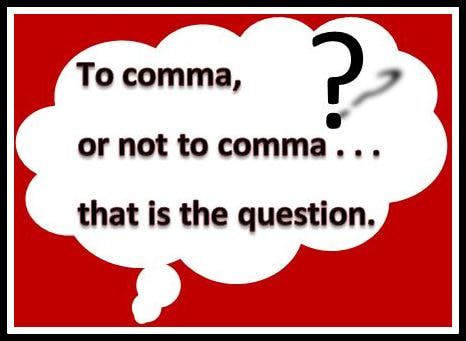The Use and Misuse of the Comma

 The comma is the most used and abused form of punctuation. It will either help the reader along with your story or annoy them with too many commas. I'm going to share a few examples of how to use the comma properly, as well as how not to use it.To Separate Parts of a Series - Use the comma to separate words, phrases, or clauses in a series. It is a substitute for a coordinating conjunction. Usually the final element in the series is preceded by and or or to end the series. i.e. John, Fred, Harry, and Frank. It helps prevent confusion because of the not infrequent appearance of and within the members of a series.To Call Attention To Adjectives - When you call attention to each adjective as individually and separately describing the noun, use a comma to separate the adjectives. i.e. a tall, dark, distinguished gentleman. A comma between adjectives has the same effect as the conjunction and. i.e. a tall and ark and distinguished gentleman.To Separate the Clauses of a Compound Sentence Joined by a Coordinating Conjunction - Use the comma to separate the independent clauses of a compound sentence when they are joined by a coordinating conjunction. The comma is placed immediately before the conjunction (and, but, or, not for, yet) to indicate that the conjunction introduces a clause. i.e. She hasn't succeeded in balancing her checkbook, yet she plans to continue writing checks. When the clauses are very short so that most or all of the sentence can be taken in instantaneously by the eye, the comma is not required. i.e. He sent for her and she came.To Separate Interjections and Similar Nonintegrated Sentence Elements - Occasionally, words or phrases in a sentence do not modify specific words, they are not subjects or verbs, they are not objects of prepositions, etc.Use the comma to set off interjections that are included in sentences. i.e. Oh, I thought so. Hey, watch your step!If the interjection occurs within the sentence, it is separated by two commas. i.e. I tried so hard, alas, to do it.Use the comma to set off any other words or phrases that behave as interjections. i.e. Yes, I'll be glad to. John, get the book.Use the comma to set off sentence modifiers. Such as however, moreover, furthermore, therefore, nevertheless, and phrases like on the other hand, in addition to. To make clear they are not intended to modify a single word, separate them from the rest of the sentence by commas. i.e. However, he caught the bus. She tried, moreover, to attain her goal.Use the comma to set off absolute phrases. Absolute phrases are not connected to the remainder of the sentence by relating words such as prepositions or conjunctions. They are therefore set off by commas. i.e. It seemed sensible, the weather being warm, to pack sunscreen.To Set Off a Long Phrase or Clause Preceding the Subject - Since the first element in an English sentence is normally its subject, any phrase or clause of five words or more preceding the subject is concluded with a comma to indicate the subject is about to appear. i.e. During the long winter of 1881, the king suffered an illness. If the phrase is four words or less, the comma is not necessary. i.e. In 1881 the king suffered an illness.To Indicate Interruptions of Normal Word Order - Normally, adjectives precede the nouns they modify, and, normally, subjects are followed by verbs or by modifying phrases or clauses. i.e. The old and respected firm in the city went bankrupt. If you want to emphasize the adjectives old and respected following the noun firm, they will then be set off by commas. i.e. The firm, old and respected, went bankrupt. The single comma should never interrupt the natural flow of a sentence, but intruding elements of any kind should be indicated by being preceded and followed by commas. i.e. The river, it seems likely, will overflow its banks.To Prevent Misreading - This is one of the most commonly misused forms of commas by leading to momentary confusion. i.e. Soon after, the meeting was adjourned. Without the comma, the reader might read after the meeting as a prepositional phrase, and this fragment would have no subject.Misuse of the Comma - Here are a few examples how "not" to use commas:The carpenter insisted, that he knew what he was doing. [The comma after insisted separates the verb from its object.]He drove a hard, sharp, painful, bargain. [The comma after painful separates the adjective painful from the word it modifies.] source: Essentials of English
The comma is the most used and abused form of punctuation. It will either help the reader along with your story or annoy them with too many commas. I'm going to share a few examples of how to use the comma properly, as well as how not to use it.To Separate Parts of a Series - Use the comma to separate words, phrases, or clauses in a series. It is a substitute for a coordinating conjunction. Usually the final element in the series is preceded by and or or to end the series. i.e. John, Fred, Harry, and Frank. It helps prevent confusion because of the not infrequent appearance of and within the members of a series.To Call Attention To Adjectives - When you call attention to each adjective as individually and separately describing the noun, use a comma to separate the adjectives. i.e. a tall, dark, distinguished gentleman. A comma between adjectives has the same effect as the conjunction and. i.e. a tall and ark and distinguished gentleman.To Separate the Clauses of a Compound Sentence Joined by a Coordinating Conjunction - Use the comma to separate the independent clauses of a compound sentence when they are joined by a coordinating conjunction. The comma is placed immediately before the conjunction (and, but, or, not for, yet) to indicate that the conjunction introduces a clause. i.e. She hasn't succeeded in balancing her checkbook, yet she plans to continue writing checks. When the clauses are very short so that most or all of the sentence can be taken in instantaneously by the eye, the comma is not required. i.e. He sent for her and she came.To Separate Interjections and Similar Nonintegrated Sentence Elements - Occasionally, words or phrases in a sentence do not modify specific words, they are not subjects or verbs, they are not objects of prepositions, etc.Use the comma to set off interjections that are included in sentences. i.e. Oh, I thought so. Hey, watch your step!If the interjection occurs within the sentence, it is separated by two commas. i.e. I tried so hard, alas, to do it.Use the comma to set off any other words or phrases that behave as interjections. i.e. Yes, I'll be glad to. John, get the book.Use the comma to set off sentence modifiers. Such as however, moreover, furthermore, therefore, nevertheless, and phrases like on the other hand, in addition to. To make clear they are not intended to modify a single word, separate them from the rest of the sentence by commas. i.e. However, he caught the bus. She tried, moreover, to attain her goal.Use the comma to set off absolute phrases. Absolute phrases are not connected to the remainder of the sentence by relating words such as prepositions or conjunctions. They are therefore set off by commas. i.e. It seemed sensible, the weather being warm, to pack sunscreen.To Set Off a Long Phrase or Clause Preceding the Subject - Since the first element in an English sentence is normally its subject, any phrase or clause of five words or more preceding the subject is concluded with a comma to indicate the subject is about to appear. i.e. During the long winter of 1881, the king suffered an illness. If the phrase is four words or less, the comma is not necessary. i.e. In 1881 the king suffered an illness.To Indicate Interruptions of Normal Word Order - Normally, adjectives precede the nouns they modify, and, normally, subjects are followed by verbs or by modifying phrases or clauses. i.e. The old and respected firm in the city went bankrupt. If you want to emphasize the adjectives old and respected following the noun firm, they will then be set off by commas. i.e. The firm, old and respected, went bankrupt. The single comma should never interrupt the natural flow of a sentence, but intruding elements of any kind should be indicated by being preceded and followed by commas. i.e. The river, it seems likely, will overflow its banks.To Prevent Misreading - This is one of the most commonly misused forms of commas by leading to momentary confusion. i.e. Soon after, the meeting was adjourned. Without the comma, the reader might read after the meeting as a prepositional phrase, and this fragment would have no subject.Misuse of the Comma - Here are a few examples how "not" to use commas:The carpenter insisted, that he knew what he was doing. [The comma after insisted separates the verb from its object.]He drove a hard, sharp, painful, bargain. [The comma after painful separates the adjective painful from the word it modifies.] source: Essentials of English
Published on November 26, 2018 04:00
No comments have been added yet.



